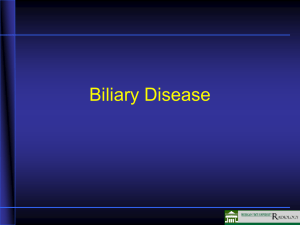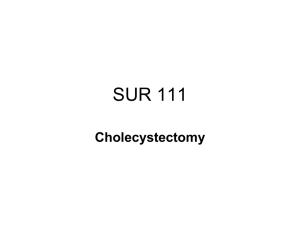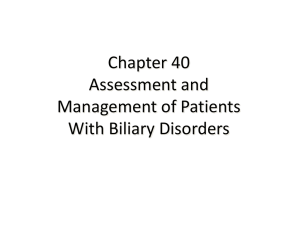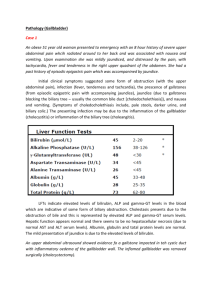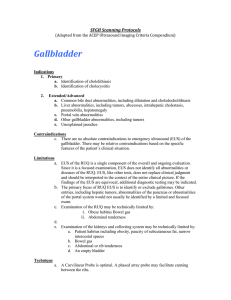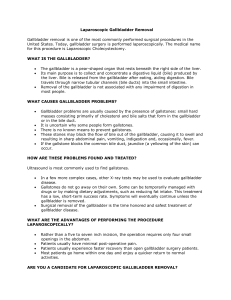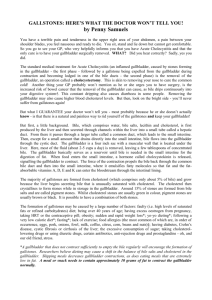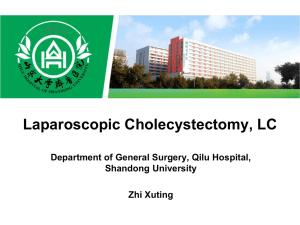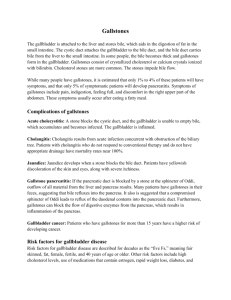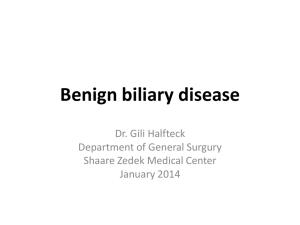Introduction: The gallbladder serves as a storage depot for bile. After
advertisement
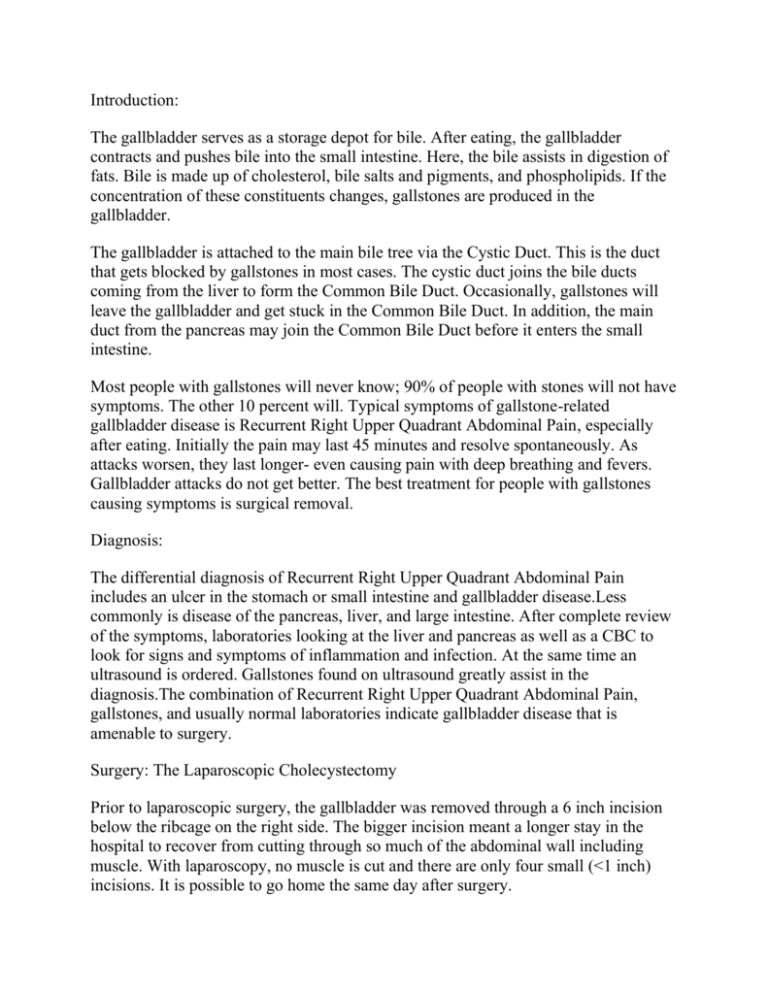
Introduction: The gallbladder serves as a storage depot for bile. After eating, the gallbladder contracts and pushes bile into the small intestine. Here, the bile assists in digestion of fats. Bile is made up of cholesterol, bile salts and pigments, and phospholipids. If the concentration of these constituents changes, gallstones are produced in the gallbladder. The gallbladder is attached to the main bile tree via the Cystic Duct. This is the duct that gets blocked by gallstones in most cases. The cystic duct joins the bile ducts coming from the liver to form the Common Bile Duct. Occasionally, gallstones will leave the gallbladder and get stuck in the Common Bile Duct. In addition, the main duct from the pancreas may join the Common Bile Duct before it enters the small intestine. Most people with gallstones will never know; 90% of people with stones will not have symptoms. The other 10 percent will. Typical symptoms of gallstone-related gallbladder disease is Recurrent Right Upper Quadrant Abdominal Pain, especially after eating. Initially the pain may last 45 minutes and resolve spontaneously. As attacks worsen, they last longer- even causing pain with deep breathing and fevers. Gallbladder attacks do not get better. The best treatment for people with gallstones causing symptoms is surgical removal. Diagnosis: The differential diagnosis of Recurrent Right Upper Quadrant Abdominal Pain includes an ulcer in the stomach or small intestine and gallbladder disease.Less commonly is disease of the pancreas, liver, and large intestine. After complete review of the symptoms, laboratories looking at the liver and pancreas as well as a CBC to look for signs and symptoms of inflammation and infection. At the same time an ultrasound is ordered. Gallstones found on ultrasound greatly assist in the diagnosis.The combination of Recurrent Right Upper Quadrant Abdominal Pain, gallstones, and usually normal laboratories indicate gallbladder disease that is amenable to surgery. Surgery: The Laparoscopic Cholecystectomy Prior to laparoscopic surgery, the gallbladder was removed through a 6 inch incision below the ribcage on the right side. The bigger incision meant a longer stay in the hospital to recover from cutting through so much of the abdominal wall including muscle. With laparoscopy, no muscle is cut and there are only four small (<1 inch) incisions. It is possible to go home the same day after surgery. The procedure is performed under general anesthesia- the patient is completely asleep. Four trocars are placed through the abdominal wall. The abdomen is inflated with carbon dioxide; this allows for plenty of room to safely remove the gallbladder. The trocars allow for the surgical instruments to be placed in to the abdomen without letting the carbon dioxide out. First the cystic duct is identified. A small incision is made in the duct and dye is placed to fill all the ducts. An x-ray like photograph (cholangiogram) will show if a stone is left in the Common Bile Duct or if the anatomy of the bile ducts is abnormal. The bile duct is clipped shut along with the artery to the gallbladder. The gallbladder is then removed from its attachments to the liver. The gallbladder is removed from the belly-button trocar site. The incisions are closed and the patient wakes up in the recovery room. What to expect immediately after surgery: It is normal to have pain in the surgical sites as well as the area under the ribs- the place where the gallbladder used to be. Nausea is also very common; this is a normal response to operating inside the abdomen. Both are relieved with pain medication and anti-nausea medications, respectively. If the pain is not adequately controlled or if the patient cannot tolerate enough liquids to keep themselves hydrated, they will be admitted to the hospital overnight. Most patients will go home the following day able to tolerate a light diet and pain medications taken by mouth. Diet after surgery: It is very common for people to tell me that they have been told to have a low-fat diet after gallbladder surgery. I believe this to be wrong advice; a low fat diet BEFORE surgery makes sense as the fatty foods are more likely to trigger a gallbladder attack. After the gallbladder is removed, there is no gallbladder for an attack. The only reason not to eat fatty foods after surgery is for overall health concerns such as your heart, atherosclerosis, and cholesterol issues. What to expect over the next several weeks: The nausea resolves in one- two days. The pain overall is markedly improved; nonnarcotic pain medications such as ibuprofen will be adequate. Pain may appear in the right shoulder. This is referred pain from the diaphragm above the liver- both the diaphragm and the shoulder skin ar innervated by the same nerves. This will subside in a few days. The appetite will return soon afterwards; any weight loss from the entire surgical experience will most likely return. Tiredness is the last symptom to go away; even though the surgery is quick with small incisions, the body treats this the same as if it were hit by a truck. People may feel more tired than normal for weeks to months. Gallbladder disease without gallstones: Biliary Dyskinesia Biliary dyskinesia is a surgical condition where the symptoms mimic gallstone related disease with Recurrent Right Upper Quadrant Abdominal Pain, however, the ultrasound does not show gallstones. The differential diagnosis is the same as gallstone related disease; ulcers, gallbladder, bile duct problems, liver and pancreas disease. The diagnosis is made with a HIDA scan- a several hour test done by radiologists to look for bile duct blockage and the function of the gallbladder. If the gallbladder has poor excretion of bile when given a hormone stimulus by the radiologist, biliary dyskinesia is more likely. Operating for biliary dyskinesia alone should not be taken lightly. The risk of continued upper abdominal pain after removing the gallbladder is much higher than for gallstone-related disease. Instead, the patient needs to be assessed more fully for symptoms related to other organs in the differential diagnosis. A gastroenterologist may be needed for review of symptoms as well as looking into the stomach and large intestine (EGD- placing a scope with camera into the stomach & Colonoscopy- the same, just in the colon).
